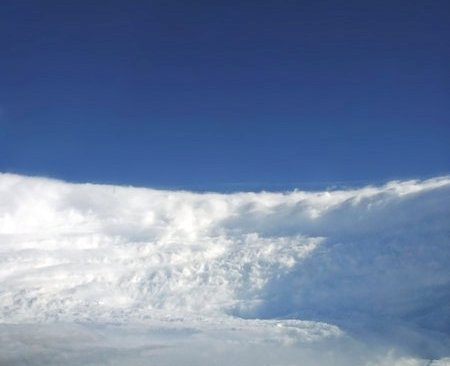
| ICE
Case Studies |
Hurricane Katrina Jessica Hulse |
I.
Case Background |

The eye of the storm

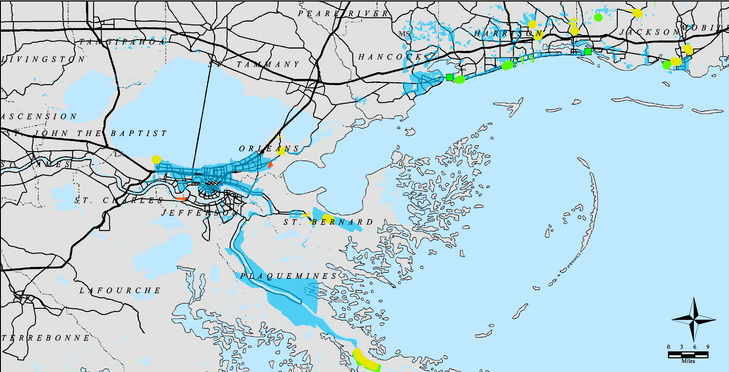
The damage caused by Hurricane Katrina in August of 2005 can be attributed to both the strength of the storm, the environmental conditions, and appendages that protected New Orleans, as well as the lack of planning on the part of multiple levels of government. Since the main damage of the storm was caused by the collapse of the levies surrounding New Orleans the working of a levy must be understood, as well as its purpose. The second element of the disaster revolves around the lack of planning on the part of the government, at the federal, state, and local level, which lead to an outbreak of lawlessness and violence among those who were still trapped in the city.
New Orleans has been hit by hurricanes before, the last being Hurricane Betsy which struck in 1965, none has ever struck with the level of intensity as Katrina. When Katrina hit land it did so with Category 3 winds, which was enough to destroy parts of the levees, flooding New Orleans. While many people had already evacuated the city, there were a number of people, mostly those of lower economic status, who became trapped. Therefore, they had to take refuge in temporary shelters throughout the city, or remained in their homes as the water levels raised. The flood waters caused all types of contamination, including sewage, dead bodies, and oil run off.
Katrina was the third strongest hurricane to make landfall in US history, the first hit on Labor Day 1935, before the naming system began, and the second was Hurricane Camille who hit in 1969. Katrina has been compared to both Camille, 1969, and Betsy, 1965, both of which struck in the same general area. In terms of the destruction wrought by Katrina it is also being compared to the Galveston Hurricane of 1900, which was also a Category 4 and caused thousands of deaths. Katrina made landfall three times, the first in Florida as a Category 1, the second near Buras, Louisiana as a Category 4, and the final time near the Louisiana/Mississippi boarder as a Category 3.
New Orleans is mostly below sea-level and is surrounded by Lake Pontchartrain, with a series of levies keeping the water from the lake from flooding into the city. Levees are built on flat pieces of land with piles of earth built up in a pyramidal shape, with a flat top so that if water levels rise too much additional earth can be added or sandbags can be piled. Due to the shifting river beds and water levels it is vitally important to constantly maintain the levees. Katrina was the second time that the Mississippi River breached the levy system, the first being in 1927, when 246 people were killed. As they began to pump the water out of New Orleans one of the repaired levees broke again, flooding parts of the city once more. There is now an investigation being launched as to why the levees were not repaired when the Army Corps of Engineers has been given money over the last 30 years to repair them when necessary.
c. Contamination
The immediate flooding of the city caused thousands of gallons of sewage and trash to combine with the water. This coupled with gasoline from ruined cars and pipelines as well as the bodies of those killed in the storm and its aftermath set the stage for a high level disease outbreak. The contaminated water is still sitting in the city, with efforts to rescue the bodies having begun later last week no one is sure of what all is flowing through the cities. Chemical plants and refineries have also released toxins into the water, as well as thousands of tons of uncooked shrimp and chicken. With the polluted water being pumped back into Lake Pontchartrain the disease and environmental ramifications are still yet to be determined.
The majority of the conflict arising from Hurricane Katrina occurred in New
Orleans where, due to the breech of the levees and the flooding, hundreds if
not thousands of people were stranded without food or water. This led to severe
looting through-out the city, including people shooting at rescue helicopters
as they tried to deliver food or evacuate hospitals, as was the case at Charity
Hospital. With the most flooded areas of the city being those where the poorest
people lived many of them were driven into general shelters such as the New
Orleans convention center and the Superdome. This also led to violence as people
were attacked and even raped by others looking for food and supplies or who
saw these shelters as an opportunity to do what they could not normally get
away with. With the stories of many of these atrocities still unfolding it will
just be a matter of time until it is known what really happened.
The storm stuck on August 29, 2005 and the clean up and the repercussions are ongoing.
Katrina affected people from Florida to Texas, in terms of property damage, loss of life, and the toll that was taken on communities that welcomed the evacuees.
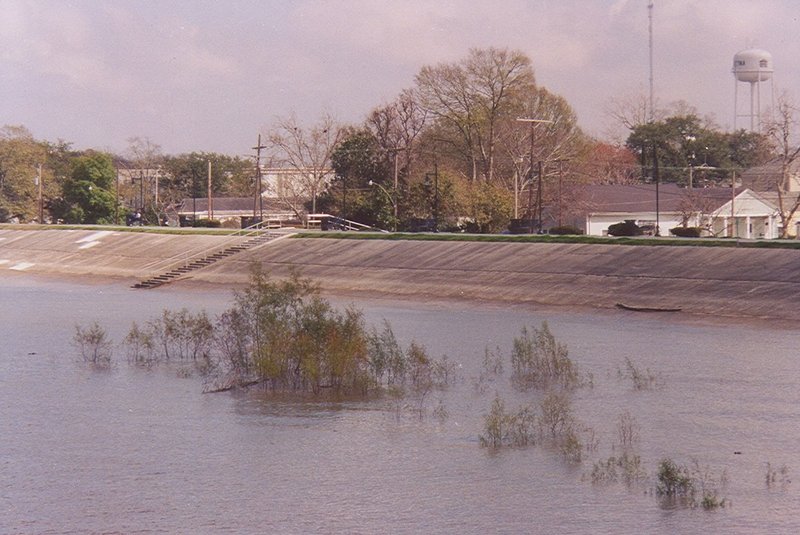
Gretna Levee, Mississippi
The role of the environment is not only involved in the destruction of Hurricane Katrina but, is both, directly responsible and was directly affected. Over the past decade it has become possible, through satellite imagery, to track storms as they form and to plot their path before they strike, which often allows people to prepare, as in the cases of Hurricanes Rita and Wilma. The reason that hurricanes move the way they do has to do with water currents, water and air temperature, and even atmospheric winds. Many have speculated that the series of hurricanes that arose this year, this being one of only two times that the Saffir-Simpson scale has been completed, with all 21 letters of the alphabet being used to name storms, could have a link to global warming and other environmental pollution
Hurricane Katrina has wrought the most damage that the Gulf Coast has ever experiences on its fragile wet lands. At the same time the lack of potable water that resulted for those who were trapped in New Orleans duo to the flooding became another environmental problem, especially when people began to drink contaminated water because that was all that they could find. As the water sat stagnant in New Orleans for days it became contaminated with various pollutants, including oil, gasoline, sewage, trash, and even with the bodies of those who died and were swept into the water. Now that this water has been returned to Lake Pontchartrain no one is sure what type of environmental problems will result in the surrounding wetlands and animal species.
In terms of dealing with the direct environmental problems wrought by Hurricane Katrina the most obvious and the most serious is the damage that was done to the wetlands. The wetlands in Louisiana and Mississippi are some of the most fragile in the country due both to their precarious position on the Gulf Coast, as well as because of the decades of abuse, in the form of pollution as well as the dredging that was done along them by the oil industry, which they have withstood. The wetlands surrounding Lake Pontchartrain are home to 125 aquatic species as well and hundreds more that live on the banks of the lake or in the surrounding areas. While it is speculated that many of these animals may have been killed in the initial strike of Katrina or will die due to lack of food and shelter in the coming months there is always the chance that a dramatically altered environment will cause these species to continue to die off. Should these animals become desperate there is always the chance that they will move towards civilization and begin to attack people in search of food.
The second issue then becomes dealing with the affects of the polluted water
on the people of New Orleans. For those who were able to evacuate before the
storm struck it will not be as large of an issue as it will be for those who
were trapped, or remained, in the city during the storm and in the following
days. When the water surged over and around the levees it ran directly into
contaminants in the form of oil and gas, from both refineries as well as from
cars that were left in the city. There was also an enormous amount of garbage
swept up into the water when was followed with the bodies of those who died
during the storm, as well as bodies that washed out of the above ground graves
that are common in New Orleans. As the days wore on that the water remained
stagnate in the city the risk to those coming into contact with it rose. Levels
of E. coli have been detected by the EPA, during their testing at the beginning
of October, through the samples they were able to collect and analyze. While
they are saying that the levels are not sever enough to worry about, there is
no way to tell where these levels were in the aftermath of the storm when people
were still trapped in the city.
The other affect that the flood water brought with them is mold. Mold has always
been a problem in New Orleans due to the damp and muggy climate. However, for
the homes and buildings that spent days partially under water the mold has grown
out of control. As people begin to return to their homes they are only allowed
to do so with protective gear, including goggles, gloves, and breathing masks.
The mold invaded everything that it came into contact with, including dry wall,
furniture, and cloth goods. The only way to properly dispose of the mold is
to destroy what ever it attacked, meaning people will be forced to tear down
homes and begin from scratch. A secondary problem from this is that many hospitals
had their lower levels completely submerged and will not be able to reopen their
doors for many months meaning that if there is an outbreak of any disease there
will not be an infrastructure in place to deal with it.
Hurricanes form in places where warm air passes over warm water to form the
hurricane itself. The southern Atlantic and the Gulf of Mexico, which Hurricane
Katrina passed over, are both warmer bodies of water which over the past hundred
years have only continued to grow warmer. This also tends to result in areas
near each other having different air pressures which are what forms the storm
itself, with the lower-pressure areas drawing in air from the higher-pressure
areas. At this point, the warm water begins to be drawn into the storm which
causes it to gain power and strength, at this point if the storm is not broken
apart by atmospheric winds it become a full fledged hurricane. The more time
a storm spends over the water the strong it will grow, therefore in the case
of Katrina it was known that the storm was coming but it took a few days for
it to reach land fall which is what allowed it to become so powerful.
Part of the reason that Katrina was so powerful was because of the tropical
nature of the surrounding area. The delicate wetlands along the Gulf Coast could
not handle the Category 4 winds that were brought to bear on them, and it is
possible that the full extent of this damage will not even be known for some
time yet. Additionally, New Orleans is a city that resides below sea level and
is protected by a series of levees which keep Lake Pontchartrain from flowing
into the city and flooding it. The levees could not sustain hits from the winds
that Katrina brought with her and collapsed under the stress returning the area
of New Orleans into what it once was.
The destruction that Katrina brought with it directed affected people and cities from Florida to Texas, making this one of the most powerful and destructive storms in history. Katrina is not completely a man-wrought disaster, in terms of a nuclear disaster, but humans did control the situations that arose in the aftermath of the storm that possibly made it harder for people to recover. However, the collapse of the man-made levees can be categorized as the catalyst for the most destruction related to the storm, many parts of New Orleans sustained such severe damage that many wonder if it is even worth it to rebuild those sections. In the case of the 9th Ward where there is a good chance that the area will simply be bulldozed and returned to swamp land due both the level of destruction as well the problems that are associated with the area due to it being built completely on swamp land.

The conflict resulting from Hurricane Katrina can be categorized as a civil conflict, because it occurred between people without the influence or monitoring by any sort of law enforcement. While a majority of the violence arose from looting, mostly for those who were trapped in the city following the collapse of the levees, including those looking for food, water, and even dry clothes, and shoes. While Katrina struck in the early hours of August 29th, by the evening of August 31st the National Guard forces had not, for the most part, arrived in New Orleans.
It has been noted that a majority of the National Guard forces from Louisiana and Mississippi are currently serving in Iraq, however National Guard units from surrounding states were waiting for orders to enter Louisiana and New Orleans. During the first few days following the storm the police offices who were in the city were mostly taking cover themselves, as bands of men were roaming the city, armed, looking for supplies. One police officer was shot in the head and killed when he walked in on a group of looters and a National Guardsman was wounded in a similar situation, and in these cases no one has been identified or apprehended.
In the case of Charity Hospital in downtown New Orleans there
were multiple incidents of shots being fired at helicopters who, in the days
after the storm, were trying to evacuate critical patients. In order to get
to the roof to evacuate the patients doctors had to carry them up multiple flights
of stairs, sometimes on their backs, and then try to avoid the sniper fire in
order to get them into a helicopter. There were even cases where the helicopters
could not land due to the shots being fired and were forced to turn back. In
these cases the doctors would often keep the patients on the roof hoping that
the helicopters would return.
While the looters were pillaging the city, the even more dangerous situations were inside of the shelters in the city. A majority of the people who could not escape Katrina were told, or taken, to the convention center or the Superdome. Once they arrived at one of those two locations there was even more lawlessness and depravity. There were no where near enough supplies for the 9,000 people in the Superdome and the nearly 20,000 trapped in the convention center. This led to violence among the evacuees in order to gain basic supplies as well as those who were so frustrated by their situation that violence was one of the only outlets left to them. There were also numerous reports of rapes in these shelters, in some cases there were witnesses but they were either too shell-shocked from what had happened to them or too afraid to come forward lest they become targets them-selves. According to many evacuees the police in New Orleans were too busy to deal with the rape allegations at the Superdome, and once the evacuees reached the Astrodome, or other shelters in Houston, the Houston police refused to process complaints due to the fact that they had happened in another jurisdiction.
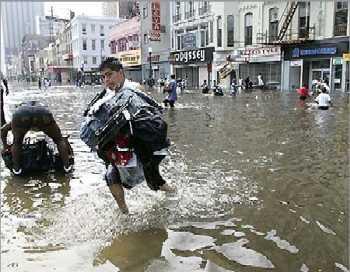
There were also stories of violence through neglect, as in the cases of nursing homes who did not heed the evacuation order. In the case of St. Rita’s the owner decided that it would be too traumatic to move some of the more elderly and infirm patients so they tried to weather the storm, and three days later 34 bodies were recovered after the flood water completely submerged the home. In recent weeks the owners of St. Rita’s, Mable and Salvador Mangano, have been charged with 34 counts of negligent homicide bringing law enforcement into the events that followed Hurricane Katrina.
According to Lt. Colonel Jacques Thibodeaux of the Louisiana National Guard,
who was responsible for security at the Superdome, the reports of rape and murder
were blown out of proportion. He claims that, "the incidents were highly
exaggerated," mostly as a result of fear and exhaustion among the evacuees
in the Superdome. He also says that his guard unit received no reports of rape
during the time they were in command of security. At the same time there are
reports from those were were staying in the Superdome or rooms with the bodies
of, "children with slit throats," as well as other corpses. There
were also unofficial reports of groups of people watching as women were dragged
off and raped while no one did anything to stop or prevent the attacks.
On Tuesday October 25th the first Katrina related case was brought to court, the case of the rape of a 13-year-old girl at Camp Dawson, which is one of the National Guard evacuee facilities in West Virginia. Damien Batiste pleaded no contest to third-degree sexual assault. While this means that he has not admitted guilt he is also offering no defense and must also register as a sex offender for the rest of his life. It is hoped that this case will help others come forward although now with evacuees scattered across the country it will be difficult to prosecute unless names are known and evidence was collected at the time.
While the level of conflict seen in the wake of Hurricane Katrina cannot be
seen as high as some wars through-out history, in terms of conflict caused by
a natural disaster it certainly ranks incredibly high. Many are calling Katrina
the most deadly natural disaster in the US since the 1909 earthquake in San
Francisco. While the death toll continues to rise the most devastating factor
of Katrina is the environmental damage that has been done and is only beginning
to be seen. The flooding of the city was a direct result of three breeches in
the levee system which surrounds most of New Orleans, the 17th Street breech,
the London Avenue breech, and the Industrial Canal breech. The flooding was
caused both by water coming over the top of the levees as well as by holes in
the levees. The water that came flooding into the city mixed with all sorts
of contaminants, including trash and dead bodies, as well as oil, run-off from
factories, and various other toxic substances. After the pumps were repaired
the goal became to get the water out of the city as quickly as possible and
therefore there was no effort made to clean the water before it was returned
to Lake Ponchatrain. Therefore, this contaminated water will now affect the
wildlife, whatever of it survived the hurricane, as well as the ground water
in the area.
The damage to the levee system might also be in such a desperate need of repair
or replacement that it will be quite a while before the people of New Orleans
can return home. The winds and waves from Hurricane Rita have already cause
flooding again in New Orleans, where the water which was almost pumped out is
now at 8 feet again in some parts of the city. Once the Army Corps of Engineers
can finally make an assessment of the situation, which cannot be done until
the water levels inside the city drop sufficiently, it is possible that the
entire system will have to be replaced.
As of October 1 the death toll from Hurricane Katrina was at 1275, which included those who died of hurricane related issues, such as elderly who died when the electricity stopped their ventilators as well as other similar situations. On October 4th officials ended the door-to-door search for bodies, meaning that they believe they have looked in all of the buildings and found all of the bodies they believe they will find. While the threat of disease appears to have been avoided there is still the possibility that there could be an outbreak of cholera or other disease which is associated with flooding and contamination. There are also hundreds of homeless who no one will miss and whose bodies many never be found and identified.
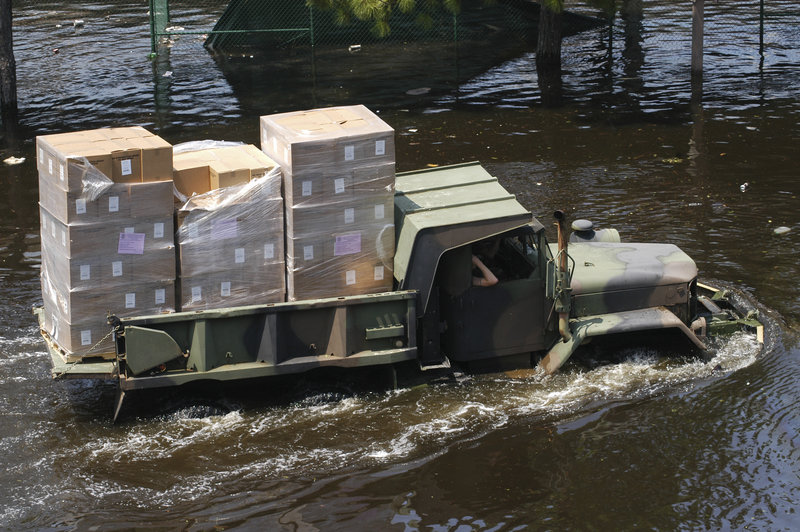
IV. Environment and Conflict Overlap
In the case of Hurricane Katrina there is a direct link between the environment and the conflict. The flooding in New Orleans was caused because the levee system that was protecting the city was not able to withstand the Category 3 winds that the storm produced. When the levees were breached the waters of Lake Pontchartrain flooded into the city, which since it is under sea level resulted in most parts of the city being under water. As the water level rose those trapped in New Orleans were forced to head for the highest ground in the city where they could be safe.
The flood waters prevented food, water, and other supplies from reaching those who were trapped. The lack of basic necessities led to looting through-out the city, some on the part of those needing necessities, some on the part of those taking advantage of the situation, such as the men who looted the guns and ammunition department of a local K-Mart.
Violence also resulted in the shelters through-out the city, such as in the
Superdome, where stories of rape and attacks rose as the days wore on. For the
most part these were crimes of opportunity, they knew that due to the situation
in the city the chances of being apprehended and imprisoned for what they had
done. This was especially evident in the cases of the random people who shot
at rescue helicopter as well as the people who looted items such as plasma televisions
and stereos.
It is also important to note that there is a possibility that if the government,
both state and federal, had responded quicker to the needs of those trapped
in the city that some of the violence could have been prevented. The stories
of National Guardsmen waiting on the borders of Louisiana to be sent to New
Orleans as well as the reports of busses waiting without drivers to evacuate
those trapped in the city show the level of confusion and inaction on the parts
of many. While it is only a hypothetical idea and clearly cannot be proven it
is important to recognize that there were opportunities at which the violence
could have been prevented.
The conflict discussed in this paper is very clearly on a sub-state level due to the fact that the violence was mostly occurring with-in New Orleans. It is very important to remember that while this paper, and most news sources, focused on the destruction wrought in New Orleans and the surrounding areas Hurricane Katrina also caused enormous amounts of damage in Alabama, and Mississippi as well as the fact that states from Florida to Texas were affected as evacuees fled over their borders in order to escape the destruction as well as to find shelter and food.
Government- In terms of the sub-state affect, Katrina is a prime example of what happens when the government fails to provide for the necessities of the people it serves. The collapse of the levee system has been blamed in some part on the government not monitoring the situation closely enough to ensure that the levees remained in a good condition. The Army Corps of Engineers were the ones who built the levees, and they are still responsible for monitoring and maintaining them. However, for reasons that are still being investigated, the levees had not been properly maintained. At the same time it must be remembered that they were only built to withstand Category 3 winds and Katrina brought with it Category 5 winds.
The true failure of the government, local, state, and federal, was in not getting more relief workers into New Orleans both before the storm hit as well as after. The looting that went on could have been prevented had there been a sufficient law enforcement structure to create a presence so that the looters did not think they could get away with their actions. While the members of the local police department, for the most part, remained in the city, most of them were preoccupied with their own property and the safety of their families. On the same note, had there been more a move to evacuate people out of the city there would have been less people looking for necessities which would have also have prevented some of the looting. The stories of their being buses waiting to transport people out of the city have been flooding the news lately, the excuse commonly being given for why the buses were not used was that there were not enough licensed bus drivers.
Had aid workers, such as those from FEMA and the Red Cross, been able to get
into New Orleans faster after the storm stuck many of the attacks in the temporary
shelters might have been able to be prevented simply by providing people with
the simple things they needed, as well as creating an atmosphere that would
not tolerate the violent attacks that occurred in the convention center as well
as in the Superdome. Also, had there been clear and obvious command structure
in place within the shelter there is a possibility that the attacks and rapes
that occurred might have been prevented.
In terms of the violence that occurred during and after Hurricane Katrina, both in terms of the environmental and human damage, it is not possible to say that one side lost or won. While the cases of looting and rape, which were committed in the immediate aftermath of the storm, did cease the damage was already done and there is no way to undo a act of violence. On the parallel level of environmental damage, people are beginning to return to their damaged homes, most of which will have to be torn down and replaced. This is due to the mold that has grown, while mold is always a problem in New Orleans for houses that were submerged in water, which was often contaminated, for a least a week the mold grown raged out of control.
While these people will once again return home there are citizens of New Orleans
who lost everything they had and have left the city forever in search of a new
life. There is also the situation of those who lived in the 9th Ward, which
contained some of the poorest people in New Orleans. This area was built directly
onto swamp land and due to the cost of rebuilding being so high it might not
be rebuilt, but simply allowed to revert to its natural status. While this might
be seen as a win for the environment, is certainly constitutes a loss for the
people who were living there who now do not know where home will be.
It is possible to hope that after the city is rebuilt, which will take years
and years, one thing that will come out of this storm as a benefit will be that
other cities will learn how to best deal with emergency situations like this.
That perhaps even the Federal Government will revise their procedures and come
up with a better way to aid victims after natural disasters such as Katrina.

Noah, the Flood, and Water as a Weapon: While water ways are often seen as a lifeline, allowing crops to grow and cities to thrive, rivers and lakes can also flood turning water into a weapon.
Khmer Rouge and Wood Exports: Flooding resulted when trees were cut down for export, which resulted in the ruination of thousands of acers of crops. This caused starvation and led to violent conflict over finite resources.
1. http://en.wikipedia.org/Vikki/Image:HurricaneEye.jpg
2. http://www.gismaps.fema.gov/2005pages/dr1603.shtm
3. http://commons.wikimedia.org/Vikki/Image:GretnaLevee.jpg
6. http://feministing.com/archives/002021.html
7. CNN, http://www.cnn.com/2005/US/09/13/katrina .impact/
8. http://www.fifteenkey.com/up loaded_images/KatrinaLooters1-783168.jpg
9. http://en.wikipedia.org/Vikki/Ma in_Page
10. CNN, http://cnn.com/2005/US/10/04/neworleans.bodies.ap/index.html
11. www.wwltv.com/topstories/stories/wwl102505abuse.387de6d.html
12.
www.blacknews.com/pr.rape101.html
[3 November 2005]